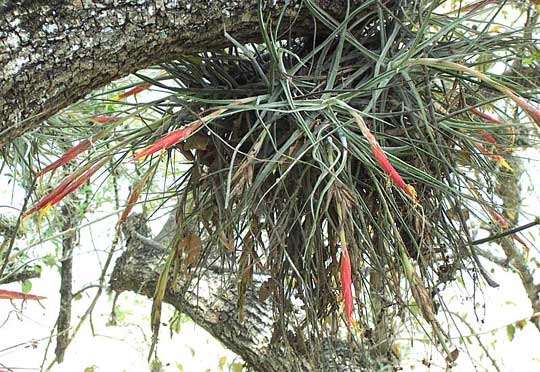Excerpts from Jim Conrad's
Naturalist Newsletter
from the April 28, 2007 Newsletter issued from Sierra Gorda Biosphere Reserve, QUERÉTARO, MÉXICO
TILLANDSIA BOUQUETS
Catching the foreign visitors' attention even more than the Aquiches were the abundant tufted clumps of epiphytic, or tree-branch-living, plants about 15 inches across, with grayish-green, grasslike leaves and long-stemmed, mostly red flower-clusters.
"Are they orchids?" people asked several times, apparently finding it hard to believe that such attractive, epiphytic plants wouldn't be orchids. In fact, until recently there were indeed plenty of yellow-flowering orchids -- the yellow-flowered Oncidiums I told you about in the March 24th Newsletter -- but it looks like someone has gone down the road collecting them. I didn't see a single orchid during our whole walk.
Anyway, the plant putting on our show was a bromeliad, probably TILLANDSIA SCHIEDEANA, a fairly common plant at this elevation from Mexico through Central America to Venezuela and Columbia. You can see one we looked at below:

In that picture the red items in the inflorescence are "bracts," or modified leaves, while the flowers are the slender, yellow things extending beyond the bracts. Bromeliad flower structure isn't like that of most garden blossoms.
If you see a tufted plant growing in a tree and its flowers are arranged in dense spikes, the blossoms themselves are small and inconspicuous but the bracts below the flowers are bright and colorful, a good guess is always "bromeliad." One way to avoid confusing epiphytic orchids with bromeliads is to remember that orchid inflorescences usually lack large, colorful bracts below each flower, and usually orchid roots attached to a tree's bark are thickish and white, while bromeliad roots are typically wiry and dark.
The Reserve's Management Program book lists 19 bromeliad species -- members of the Bromeliad Family, the Bromeliaceae -- of which 13 species belong to the genus Tilandsia.
What a treat to be walking down a road and see something as pretty as this Tilandsia simply growing in a tree next to you. But, what a pain that somebody has gone down that same road stealing the orchids from us all!